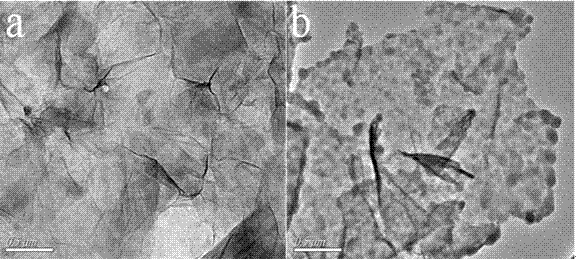Active/controllable graphene oxide surface ion imprinted polymer, and preparation method and application thereof
A graphene surface, ion imprinting technology, applied in chemical instruments and methods, other chemical processes, water/sewage treatment, etc., can solve the problem of slow adsorption rate, template molecules cannot be completely eluted, and the thickness of the surface polymer layer is uncontrollable, etc. problem, to achieve the effect of large adsorption capacity, good adsorption effect, and avoid incomplete elution
- Summary
- Abstract
- Description
- Claims
- Application Information
AI Technical Summary
Problems solved by technology
Method used
Image
Examples
Embodiment 1
[0043] (1) Place the beaker in an ice bath and add 23 mL of concentrated sulfuric acid (98% mass fraction). Then, under stirring condition, add 1 g of colloidal graphite powder and 0.5 g of sodium nitrate. Then, under vigorous stirring, 3 g of potassium permanganate was slowly added, and the reaction temperature was kept below 20 °C for 5 min. Then, the temperature was raised to 35 °C, and the reaction was continued for 30 min; after the reaction, 46 mL of deionized water was slowly added, and the temperature was raised to 98 °C, and the reaction was continued for 15 min; 140 mL of 60 °C deionized water and 7 mL of hydrogen peroxide (30% by mass) was added to the above mixed solution until the solution turned yellow-brown to end the reaction. Filter and wash with deionized water to pH = 7.0; finally, the obtained graphite oxide was dispersed in deionized water, ultrasonicated for 15 min, high-speed centrifuged, and vacuum-dried at 50 °C to obtain graphene oxide, namely GO.
...
Embodiment 2
[0056] (1) Place the beaker in an ice-water bath, and add 46 mL of concentrated sulfuric acid (98% mass fraction). Then, under stirring condition, add 2 g of colloidal graphite powder and 1 g of sodium nitrate. Under strong stirring, 6 g of potassium permanganate was slowly added, and the reaction temperature was kept below 20 °C for 15 min; then, the temperature was raised to 35 °C and the reaction was continued for 45 min. After the reaction, 92 mL of deionized water was slowly added, and the temperature was raised to 98 °C, and the reaction was continued for 20 min; 280 mL of deionized water at 60 °C and 14 mL of hydrogen peroxide (mass fraction 30%) were added to the above mixed solution , until the solution turns yellowish-brown, the reaction is terminated; filter, and wash with deionized water to pH=7.0, the obtained graphite oxide is dispersed in deionized water, ultrasonicated for 15 min, high-speed centrifuged, and vacuum-dried at 50 °C to obtain graphene oxide , nam...
Embodiment 3
[0068] (1) Place the beaker in an ice-water bath, and add 92 mL of concentrated sulfuric acid (mass fraction 98%). Then, under stirring condition, add 4 g of colloidal graphite powder and 2 g of sodium nitrate. Under strong stirring, 12 g of potassium permanganate was slowly added, and the reaction temperature was kept below 20 °C for 30 min; the temperature was raised to 40 °C and the reaction was continued for 60 min. After the reaction, 184 mL of deionized water was slowly added, and the temperature was raised to 98 °C, and the reaction was continued for 20 min; 560 mL of deionized water at 60 °C and 28 mL of hydrogen peroxide (mass fraction 30%) were added to step (1) Mix the solution in until the solution turns yellow-brown, and the reaction is terminated. Filter and wash with deionized water to pH=7.0. Finally, the obtained graphite oxide was dispersed in deionized water and ultrasonicated for 15 min. After high-speed centrifugation and vacuum drying at 50 °C, graphen...
PUM
| Property | Measurement | Unit |
|---|---|---|
| adsorption capacity | aaaaa | aaaaa |
| adsorption capacity | aaaaa | aaaaa |
| adsorption capacity | aaaaa | aaaaa |
Abstract
Description
Claims
Application Information
 Login to View More
Login to View More - R&D
- Intellectual Property
- Life Sciences
- Materials
- Tech Scout
- Unparalleled Data Quality
- Higher Quality Content
- 60% Fewer Hallucinations
Browse by: Latest US Patents, China's latest patents, Technical Efficacy Thesaurus, Application Domain, Technology Topic, Popular Technical Reports.
© 2025 PatSnap. All rights reserved.Legal|Privacy policy|Modern Slavery Act Transparency Statement|Sitemap|About US| Contact US: help@patsnap.com

